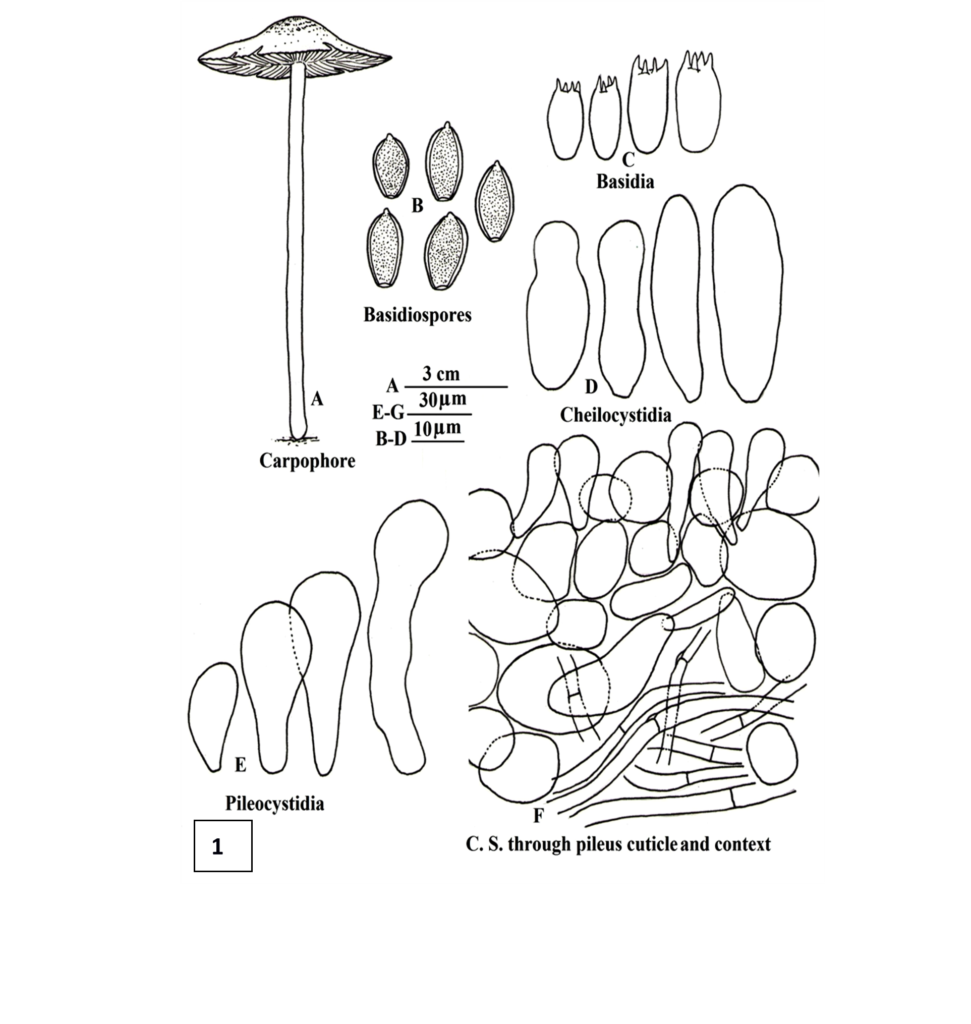Agrocybe sacchari (Murr.) Dennis
MycoBank number: MB 292343; Index Fungorum Number: IF 292343; Facesoffungi Number: FoF 10427;
Agrocybe sacchari (Murr.) Dennis, Bull. Soc. Myco. Fr. 69 (2): 180, 1953.
Synonym
Naucoria sacchari Murrill, Mycologia, 4 (2): 79, 1912.
Description
Humicolous, growing solitary, scattered on humicolous soil. Sexual state: Carpophores 3–18.5 cm in height. Pileus 2.3–5.8 cm broad, convex when young, applanate at maturity; broadly umbonate; light brown (6D4) with brownish orange (5C3) center; scaly, scales powdery; surface moist; margin regular, splitting at maturity; cuticle fully peeling; flesh upto 0.1–0.4 cm thick, offwhite, membranous, unchanging. Pileal veil absent. Lamellae adnexed; subdistant; equal; moderately broad (upto 0.4 cm); brown (6E7), unchanging; gill edges smooth; normal. Spore print pale yellow (4A3). Stipe central, 2–18 cm long, 0.1–0.6 cm broad, equal in diameter throughout; white (5A1), unchanging on exposure; hollow; smooth; exannulate. Basidiospores 10.2–13.6 × 6.8–8.5 µm (excluding apiculus) (Q=1.5) ellipsoid, lentiform; no decoloration in conc. H2SO4; turning dark brown in KOH; granular; apical pore present; apiculate, apiculus upto 1.7 µm long. Basidia 15.3–17 × 7.7–8.5 µm, clavate, –4 spored; sterigmata 1.7–2.6 µm long. Pleurocystidia absent. Cheilocystidia 22.1–37.4 × 8.5–13.6 µm, cylindrical to lageniform; gill edges sterile. Carpophore context homoiomerous. Pileus cuticle cellular, gelatinized, made up of spherical, hyaline, 37.8–61.5 × 18.9–28.4 µm cells, interspersed with pileocystidia. Pileocystidia 17.74–44.78 × 8.45–13.52 µm, claviform, hyaline; pileus context made up of 11.8–16.6 µm broad hyphae. Stipe cuticle hyphal, made up of longitudinally tangled 18.9–33.1 µm broad, septate hyphae. Clamp connections present in pileus context. Asexual state: not observed, but see notes.
Material examined: INDIA, growing solitary, scattered on humicolous soi, 24 July 2009, Jagdeep Kaur, PUN 4085.
Distribution: Singer (1977) reported Agrocybe sacchari growing solitary or in fascicles on the ground in shady places under trees and bushes, among litter and grasses.
Notes: The above examined collections belong to section Pediadeae of subgenus Agrocybe of family Strophariaceae. The gross external and internal details of this collection match well with those given for Agrocybe sacchari (Murr.) Dennis by Singer (1977). It is characterized by having a broadly umbonate pileus, long, white, unchanging stipe with smooth surface, microscopically basidiospores do not decolor in conc. H2SO4, turning dark brown in KOH, cheilocystidia present while pleurocystidia are lacking and pileus cuticle cellular with abundant pileocystidia present and clamp connections present in pileus context. This is a new fungus record from India. Consumption Habit: Edibility unknown.

Fig. 1 Agrocybe sacchari (Murr.) Dennis: Camera Lucida drawings (A Carpophore. B Basidiospores. C Basidia. D Cheilocystidia. E Pileocystidia. F C. S. through pileus cuticle & context).
